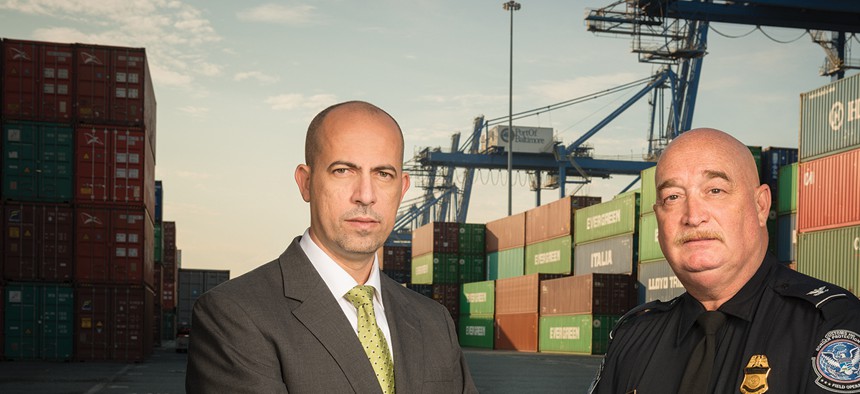
Sam Kittner/Kittner.com
How Mobile Tech is Helping DHS Combat Traffickers and Smugglers
Mobile technology is giving agents the ability to instantly take down suspects at airports and border crossings.
When confronting suspicious travelers, U.S. Customs and Border Protection (CPB) agents must make decisions based on information at hand.
Nael Samha, a program manager in CPB’s Office of Technology, and Thomas Roland, Jr., a program manager in the Office of Field Operations, developed mobile technology that for the first time gives agents working outside the office the ability to instantly scan travel documents and conduct background checks on suspects at airports and border crossings. This has resulted in increased arrests of drug traffickers, weapons smugglers, illegal immigrants, currency violators and individuals with outstanding arrest warrants.
Samha led the team of engineers and developers that created the hand-held application and supervised the many technical aspects of the project, ensuring that all security requirements were met. Roland understood the needs of field CBP officers and border patrol agents, and determined how it could be used most effectively on a day-to-day basis. Both were involved in the pilot testing, the roll out and expansion of the program, the training of personnel.
CPB officials said the technology has contributed to more than 450 successful enforcement actions since first implemented in 2010. In addition, it is now being used by CBP agriculture specialists and officers at U.S. seaports to check and immediately release imported agricultural cargo that has passed inspection. Previously, agents conducted inspections and hours later, upon return to the office, entered inspection reports to remove cargo holds, often resulting in needless delays that cost businesses money and put the quality of the perishable products at risk.
“This is absolutely a game-changer for us,” said John Wagner of CBP’s Office of Field Operations. “It gives us the ability to run database queries in locations where agents are not standing in front of desktop computers. It gives us the chance to be more reactive and to conduct more law enforcement operations outside traditional areas, and to increase the number of apprehensions and seizures.”
Roland said he and Samha work closely together. “I am a law enforcement officer who wants to be a geek, and Nael is a geek who wants to be a law enforcement officer.”
Samha said the device enables CBP officers to “protect the nation by stopping people who are smuggling drugs and weapons and engaged in money laundering. “That’s what’s important to me,” he said.
This profile is part of a series featuring the recipients of the 2012 Samuel J. Heyman Service to America Medals. Presented to outstanding public servants by the nonprofit Partnership for Public Service, and sponsored in part by Bloomberg, Booz Allen Hamilton, The Boston Consulting Group, Chevron and United Technologies Corporation, the prestigious Sammies awards are offered in nine categories. To nominate a federal employee for a 2013 medal go to servicetoamericamedals.org.
Learn from experts, innovators and your peers about the impact of technology on the future of government programs and citizen outreach. Join us on December 3 in Washington DC for Nextgov Prime, the defining event in the federal technology landscape. Learn more at nextgov.com/prime
NEXT STORY: Postal Service debuts self-service kiosks






